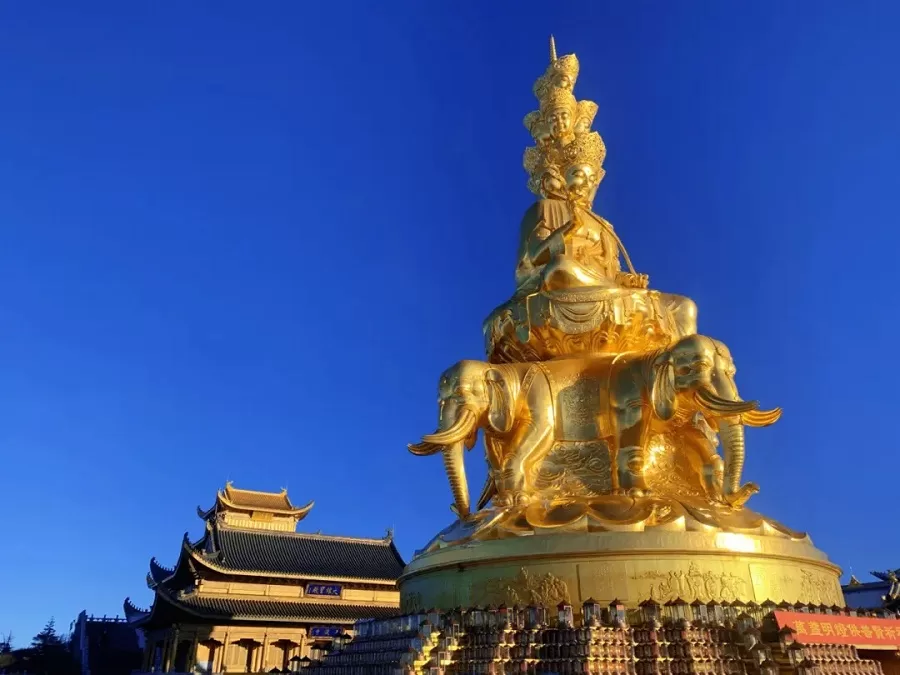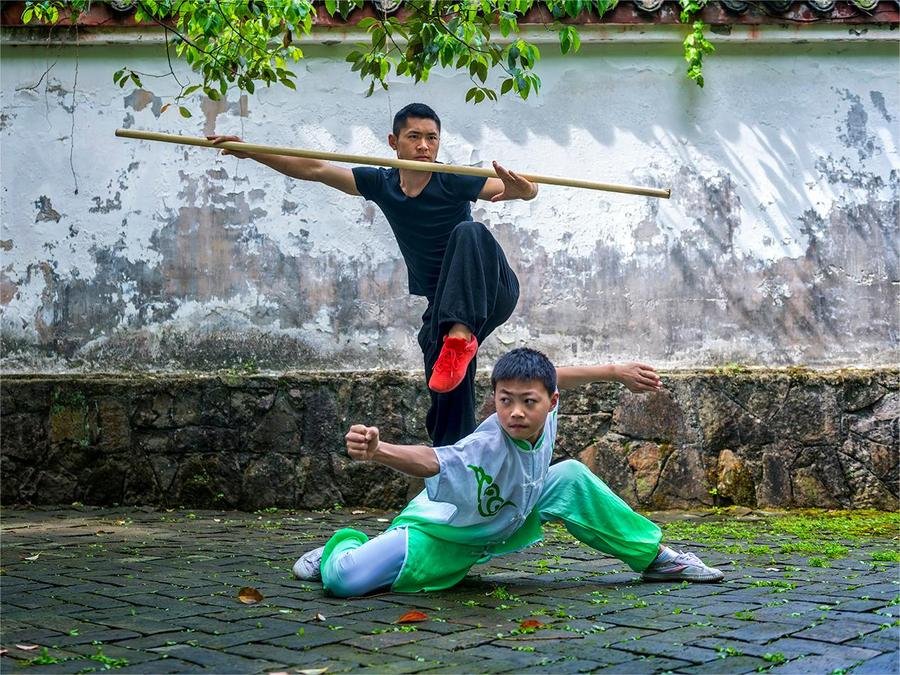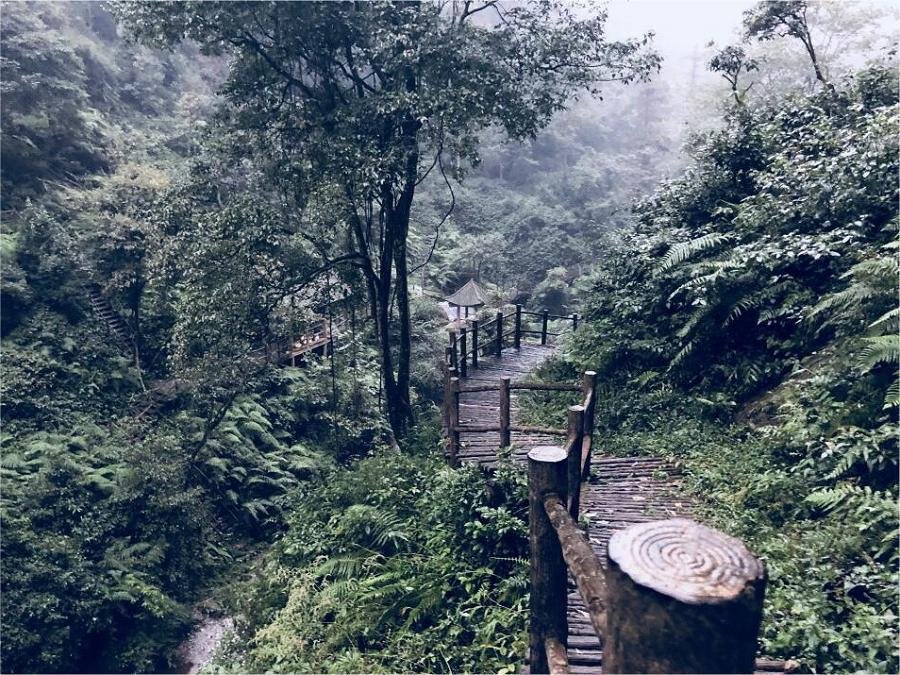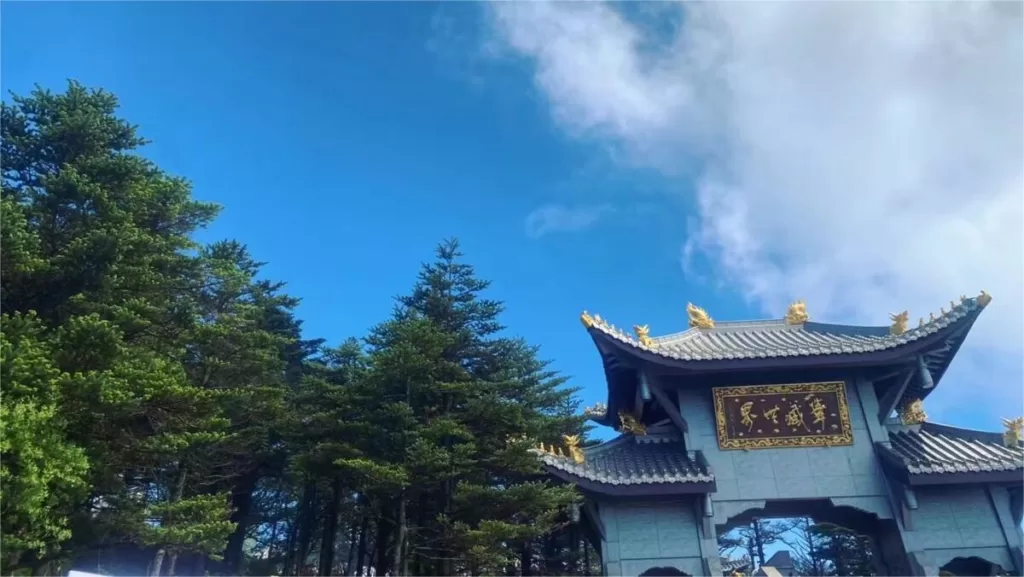Mount Emei (峨眉山, E’mei Mountain), located in Sichuan Province, China, is one of the most renowned and sacred mountains in Chinese Buddhism. Standing at a majestic height of 3,099 meters (10,167 feet), it is a UNESCO World Heritage site and attracts countless visitors from around the world.
Mount Emei boasts breathtaking natural beauty, with its lush forests, cascading waterfalls, and diverse wildlife. The mountain is also home to numerous ancient temples, which hold great religious and cultural significance. One of the most notable is the Baoguo Temple, which dates back over 1,000 years and houses precious Buddhist relics.
Pilgrims and tourists alike embark on a spiritual journey up the mountain, following ancient stone steps and winding paths. Along the way, they encounter sacred sites such as the Wannian Temple, known for its massive bronze statue of Puxian Bodhisattva, and the Golden Summit, the highest peak of Mount Emei, where the awe-inspiring golden statue of Samantabhadra stands.
Aside from its religious importance, Mount Emei offers a range of outdoor activities. Visitors can hike through enchanting bamboo forests, soak in hot springs, and marvel at the panoramic views from the mountain’s various lookout points. The picturesque scenery transforms with the changing seasons, making every visit a unique experience.
Mount Emei is not only a destination of natural beauty and spiritual significance but also a place of tranquility and reflection. Whether you seek adventure, cultural immersion, or inner peace, a visit to Mount Emei promises an unforgettable journey into the heart of Chinese Buddhism and nature’s grandeur.
Table of Contents
- Basic Information
- Location and Transportation
- Highlights of Emei Mountain
- Vlog about Mount Emei
- Useful Tips from Genuine Reviews
- Facts about mount Emei
Basic Information
| Website | http://www.ems517.com/ |
| Estimated Length of Tour | 1 – 2 days |
| Ticket Price | 160 RMB (16th January – 14th December) 110 RMB (15th December – 15th January the next year) |
| Cable Car Price | Up the mountain: 65 RMB Down the mountain: 55 RMB |
| Temple Ticket Price | Wannian Temple: 10 RMB Baoguo Temple: 8 RMB Fuhu Temple: 6 RMB |
| Opening Hours | 6.00 – 17.00 (1st May – 31st October) 7.00 – 16.00 (1st November – 30th April) |
| Telephone Number | 0086-0833-5523646 |
Location and Transportation
Mount Emei is situated in southwestern China, specifically in the province of Sichuan. It is part of the Emeishan Mountain Range, which spans across the border of Sichuan and neighboring provinces. The mountain itself is located within the boundaries of Emeishan City, approximately 160 kilometers (100 miles) southwest of Chengdu, the capital city of Sichuan Province. To get there from Chengdu, you can choose the following ways:
Coach: There are express coaches departing from Xinnanmen Bus Station (新南门车站) to Mount Emei every day. This option will take you about 3 hours and costs 42 RMB.
High-Speed Train: There are numerous trains from Chengdu to Mount Emei every day. They generally cost 60 RMB and take about 1 hour and 10 minutes. This is definitely the most convenient way to get to the attraction.
Highlights of Emei Mountain
Golden Summit

The Golden Summit (Jinding) is the pinnacle of Mount Emei, reaching a lofty elevation of 3,099 meters (10,167 feet). It is the highest peak of the mountain and holds great spiritual significance in Chinese Buddhism. At the summit, visitors are greeted by the magnificent sight of the golden statue of Samantabhadra, standing tall at 48 meters (157 feet). This awe-inspiring statue, adorned in gold, symbolizes wisdom and compassion. From the Golden Summit, one can witness breathtaking panoramic views of the surrounding mountains, clouds, and mist, immersing in a serene and ethereal atmosphere.
Wanfo Summit

Wanfo Summit, situated atop Mount Emei, is not only the highest scenic spot and natural ecological protection area among China’s four sacred Buddhist mountains but also the world’s highest natural and cultural heritage site. With an elevation of 3099 meters, Wanfo Summit was originally home to a temple called Wenshu An, also known as Qingliang An or Jile Tang, built during the Ming Dynasty in the Zhengde era. It was rebuilt in the 11th year of the Guangxu reign in the Qing Dynasty, and a scripture hall was added to house thousands of Buddhist scriptures. Wanfo Summit, along with Qianfo Summit and Golden Summit, forms a majestic array of peaks resembling a crown when viewed from below, giving rise to the saying “the crown of Mount Emei.”
Jieyin Hall

Jieyin Hall, known as Xindian during the Song Dynasty, is located at the foot of the mountain at an altitude of 2540 meters. Initially named Jieyin An, or Chaoyang Ge, it is surrounded by ancient scenic spots such as “Combing under the Moonlight,” “Sleeping on Clouds,” “Watching the Light from the Stage,” and “Evening Glow from the Divine Lamp.” Jieyin Hall is a three-story complex consisting of a front hall (Mile Hall), a middle hall (Daxiong Hall), and a rear hall (Amitabha Hall), arranged in a quadrangle layout with the main building featuring a full-frame cement brick and stone structure, a double-eaved roof, and glazed tile roofing. The plain brick and stone base are complemented by a multi-level Ruyi-style path leading to the hall, which sits on a platform with a height difference of 25 meters between the front and back.
Elephant Bathing Pool

The Elephant Bathing Pool (Xi Xiang Chi), one of the eight major temples on Mount Emei, sits at an altitude of 2070 meters on the Zuantian Slope. Originally just a pavilion known as Chuxi Pavilion during the Ming Dynasty, it was later rebuilt into an abbey called Chuxi Monastery. In the 38th year of the Kangxi reign in the Qing Dynasty (1699 AD), the abbey was renovated by Xingneng, also known as Master Hongchuan, and transformed into a temple. In the early years of the Qianlong reign (1736 AD), Monk Yuezhen renovated the road in front of the temple and behind the temple, and transformed the small pool in front of the temple into a hexagonal pond, placing a stone elephant on its bank to symbolize the legend of Bodhisattva Samantabhadra bathing the elephant. Hence, the name was changed to the Elephant Bathing Pool, also known as Tianhua Zen Temple. The Elephant Bathing Pool comprises Mile Hall, Daxiong Hall, Guanyin Hall, as well as a scripture hall and guest rooms.
Xianfeng Temple

Xianfeng Temple, one of the eight major temples on Mount Emei, is located below Xianfeng Rock, originally named Ciyanshi, at an altitude of 1725 meters, with the entrance facing Huayan Peak. The temple was founded in the 18th year of the Yuan Dynasty’s Zhiyuan era (1281 AD) as a small hermitage. In the early Ming Dynasty, the temple had a scripture hall specially built to store the imperial scriptures bestowed by Emperor Shenzong. In the 40th year of the Wanli reign (1612 AD), Master Benjiong expanded it into a large temple named “Xianfeng Zen Temple.” It was destroyed by fire in the 16th year of the Chongzhen reign (1643 AD). In the 44th year of the Qianlong reign (1779 AD), monks Tai’an and Yusheng rebuilt it, renaming it “Xianfeng Temple,” a name that has been used ever since.
Ninety-Nine Bends

The Ninety-Nine Bends, or Jiushijiu Dao Guai, is a famous treacherous slope on Mount Emei, starting from Lingxiao Pavilion and ending at Shouxing Bridge. Each bend leads to another, each slope connects to the next, and as you reach the end of one slope, suddenly the road twists and turns, leading to yet another slope. Legend has it that when Samantabhadra Bodhisattva came to Mount Emei to establish his monastery, he passed through this area and saw its steep and perilous terrain. He instructed three thousand divine beings accompanying him to each build a step, resulting in the creation of the stone steps. When they finished, there were exactly ninety-nine bends, hence the name of the slope.
Wannian Temple

Wannian Temple, located on Mount Emei, is about 15 kilometers uphill from Baoguo Temple at the foot of the mountain, near Lion Ridge. The temple was first built during the Eastern Jin Dynasty and was originally called Puxian Temple. During the reign of Emperor Xizong of the Tang Dynasty, Master Huitong rebuilt it and renamed it Baishui Temple. During the Song Dynasty, it was renamed Baishui Puxian Temple. In the 29th year of the Wanli reign (1601 AD), Emperor Shenzong renamed it Shengshou Wannian Temple to celebrate the Empress Dowager’s 70th birthday. Behind the beamless brick hall is the famous “Hall of Vows,” where the three treasures of Wannian Temple, the Buddha’s tooth, the Lotus Sutra, and the imperial seal, are enshrined. Wannian Temple consists of the Mahavira Hall, the Majestic Hall, the Hall of Vows, the Dining Hall, the Maitreya Hall, the Vimalakirti Hall, and the Prajna Hall.
Qingyin Pavilion

Qingyin Pavilion, also known as Woyun Temple, is one of the key eight major temples on Mount Emei. It was built during the reign of Emperor Xizong of the Tang Dynasty by Master Huitong and houses statues of Shakyamuni, Manjushri, and Samantabhadra. Constructed in the fourth year of the Tang Xizong reign (877 AD), during the early Ming Dynasty, Master Guangji took the meaning from the poem “Inviting the Recluse” by the Jin Dynasty poet Zuo Si, renaming it Qingyin Pavilion. Situated on a mountain ridge between the Black Dragon River and the White Dragon River, the pavilion is perched in a precarious position, surrounded by dense forests.
Chunyang Hall

Chunyang Hall, originally named Lv Xianhang Cave, is located below Chicheng Peak and was established during the Wanli reign of the Ming Dynasty. The current hall was rebuilt during the Qianlong and Jiaqing reigns of the Qing Dynasty. Chunyang Hall consists of two main halls. The first hall is the Medicine Buddha Hall, housing a statue of the Medicine Buddha flanked by the Bodhisattvas Suryaprabha and Chandraprabha, both made of bronze with gold ornaments, dating back to the Qing Dynasty. The second hall is the Great Hero Hall, housing a statue of Shakyamuni Buddha with eighteen Arhats on each side, as well as niches containing statues of Samantabhadra, Ksitigarbha, Avalokiteshvara, and Manjushri, along with a statue of Skanda. Behind the overgrown grass, two stone tablets are still preserved with clear inscriptions, reflecting Mount Emei’s history of the coexistence of Buddhism and Taoism before the flourishing of Buddhism and the disappearance of Taoist hermits.
Leiyin Temple

Leiyin Temple, established during the Jiajing and Longqing reigns of the Ming Dynasty (around 1522-1572 AD) as an Avalokiteshvara Hall, is situated at an altitude of 733 meters. During the Wanli reign of the Ming Dynasty (around 1573 AD), Master Wuxia constructed a hut here. Legend has it that Master Wuxia subdued bears with his concentration and tamed tigers with his enlightenment, earning widespread renown. In the early Qing Dynasty, the temple was temporarily renamed Jietuo An, and in the 10th year of the Guangxu reign (1884 AD), it was rebuilt and renamed Leiyin Temple to commemorate his achievements.
Baoguo Temple

Baoguo Temple, situated at the foot of Mount Emei at an altitude of 551 meters, is the first temple on Mount Emei. It also serves as the headquarters of the Mount Emei Buddhist Association and the center for Buddhist activities on the mountain. The grand plaque above the mountain gate, inscribed with “报国寺(Baoguo Temple),” was personally written by Emperor Kangxi of the Qing Dynasty. The main hall hangs a plaque reading “宝相庄严 (Magnificent Treasure).” On the pillars beside the gate, a couplet reads: “凤凰展翅朝金阙,钟磬频闻落玉阶 (The phoenix spreads its wings towards the golden palace, and the sound of bells and chimes is heard on the jade steps).” There are horizontal inscriptions that read “普照禅林 (Illuminating the Zen Forest)” and “普放光明 (Shining the Light Everywhere).”
Fuhu Temple

Fuhu Temple, one of the eight major temples on Mount Emei, was originally built during the Tang Dynasty and underwent renovations during the Southern Song Dynasty. During the Qing Dynasty, Master Guanzhi rebuilt it, a process that took twenty years, making it one of the largest temples on the entire mountain. Upon entering the temple gate, visitors are greeted by the Maitreya Hall, which houses a golden clay statue of Maitreya Buddha seated, flanked by four Heavenly Kings on each side. Behind the Maitreya Hall is the Weituo Hall, which contains a statue of Weituo. Within the temple grounds, there is a Huayan Pagoda Pavilion, featuring a 5.8-meter tall copper Huayan Pagoda from the Ming Dynasty, consisting of 14 layers and adorned with over 4,700 small Buddha statues, with excerpts from the “Avatamsaka Sutra” engraved on its body.
Dafo Zen Academy

Dafo Zen Academy (Giant Buddha Zen Academy), with its gate facing east, comprises eleven courtyards, arranged in an orderly manner from east to west. The Great Brightness Tower, housing the Medicine Buddha Hall, faces south towards the city along Foguang South Road, serving as the entrance to the academy. Covering an area of over 400 acres, with a building area of 56,000 square meters, it stands as one of Asia’s largest Buddhist complexes. Divided into three functional areas, the northern part serves as a religious worship area, the central part as a shared area for Buddhist cultural enjoyment, and the southern part as an educational area for the Sichuan Buddhist Academy.
Emei martial arts

Emei martial arts, originating from Mount Emei, is one of the three major schools of Chinese martial arts, alongside Shaolin and Wudang. According to historical records, Emei martial arts originated in the Yin and Shang dynasties and flourished during the Southern Song Dynasty. It has a long history and integrates elements of both Buddhist and Taoist martial arts. Emei martial arts emphasize footwork, elbow techniques in close combat, throwing and grappling in close quarters, and is known for its fluid movements. It is said to have “feet like a drunkard, hands like lightning, head like waves, and body like a willow.”
Hot Springs

Nestled amidst the natural beauty of Mount Emei, there are soothing hot springs that offer a delightful respite for weary travelers. These hot springs are known for their therapeutic properties and relaxation benefits. The warm mineral-rich waters rejuvenate the body and soothe the mind, providing a tranquil escape from the hustle and bustle of daily life. Visitors can immerse themselves in the rejuvenating pools while taking in the serene surroundings. The hot springs of Mount Emei create a perfect harmony between nature and wellness, allowing visitors to unwind, recharge, and indulge in the healing powers of these natural geothermal treasures.
Scenic Hiking Trails

Mount Emei offers a network of scenic hiking trails that wind through its enchanting landscapes. The most popular route is the path from Baoguo Temple to the Golden Summit, offering breathtaking views of bamboo forests, cascading waterfalls, and hidden temples. The trail showcases the diverse flora and fauna of the region, with opportunities to spot wildlife, including the playful Emei macaques. Along the way, hikers can immerse themselves in the serene beauty of nature, enjoy the crisp mountain air, and listen to the soothing sounds of flowing streams. These hiking trails provide an unforgettable journey of exploration, tranquility, and natural wonders.
Monkeys of Mount Emei

One of the captivating features of Mount Emei is its lively population of monkeys, known as Emei macaques. These mischievous and charismatic creatures add an element of excitement to the mountain experience. As visitors explore the trails and temples, they may encounter these playful monkeys swinging from trees, interacting with each other, or curiously observing passersby. While their antics can be entertaining, it’s important to maintain a respectful distance and follow guidelines to ensure the safety of both humans and monkeys.
Vlog about Mount Emei
Useful Tips from Genuine Reviews
Accommodation Options:
- Consider staying near Baoguo Temple for proximity to the entrance and the availability of hot spring hotels.
- Emeishan City is another accommodation option, but transportation to the main entrance might require a taxi.
- Spending the night at the Golden Summit is recommended for those interested in witnessing the sunrise.
Local Cuisine:
- Dining near the Baoguo Temple bus station is convenient, but some recommend trying eateries near the bridge for dishes like eel, sweet duck skin, radish soup, and well-prepared stir-fried dishes.
Sunrise Viewing:
- Sunrise at the Golden Summit is highly recommended. The first cable car to the summit starts at 7 a.m., so early risers should plan accordingly.
- If staying in Leidongping, consider leaving for the summit around 4:30 a.m. for a sunrise experience.
Provisions for the Journey:
- Prices for food items on the mountain are high; it’s advisable to carry some snacks, like instant noodles and sausages.
- Bring your own bottle as you can find hot water along the way.
Monkey Awareness:
- Beware of monkeys on Mount Emei. Avoid carrying strong-smelling food and do not hold it visibly, as monkeys may attempt to snatch it.
Clothing and Altitude Considerations:
- Due to the high altitude, temperatures on Mount Emei can be low. Wear warm and easily removable sportswear.
- Feather jackets and shawls can be rented or purchased within the scenic area.
Time Management:
- The size of Mount Emei makes it advisable to plan a two-day visit to fully explore the area.
- Avoid entering the mountain after 5 p.m., as it gets dark quickly, and the lack of lighting on the mountain paths can be challenging.
Caution with Strangers:
- Exercise caution with strangers who approach; many might be attempting to sell products. Be wary of scams and avoid trusting unsolicited approaches.





